Home » Gemstones » Opal » Synthetic Opal
Synthetic Opal
Author: Hobart M. King, PhD, GIA Graduate Gemologist
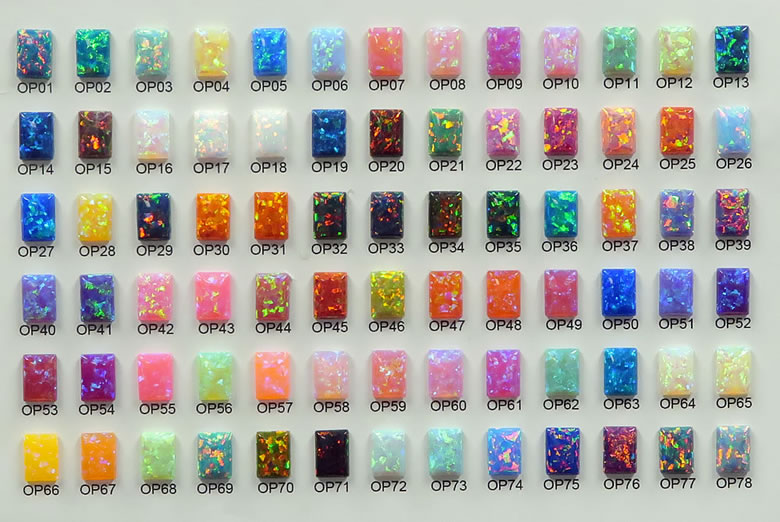
Synthetic Opal Color Samples: A sample card displaying a collection of synthetic opal cabochons of various colors. This collection clearly illustrates the abilities of a synthetic opal manufacturer. We sent a cabochon from one of these cards (OP70) to the Gemological Institute of America's lab for identification. They called it "laboratory-grown opal" with a black background color, treated by impregnation. [1] We believe that these synthetic opals were manufactured by the Kyocera Corporation of Japan, but the card and its packaging do not indicate a manufacturer. Kyocera has been a leading manufacturer of synthetic opal since the 1990s.
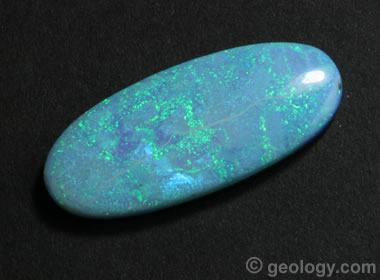
Sterling Opal: The cabochon above was cut from synthetic opal produced by Sterling Opal of Phoenix, Arizona. It measures 27 x 12 millimeters in size. On their website they state: "Our opal is lab grown in America by simply speeding up Mother Nature's process. Its beauty, variety, and durability makes it the best cultured opal in the world."
What Are Synthetic Opals?
Synthetic opals are man-made opals that have the same chemical composition, internal structure, physical properties, and appearance as natural opals. They are often called lab-created opals, lab-grown opals, or cultured opals to indicate their man-made origin.
Synthetic opals can exhibit a spectacular play-of-color appearance that often exceeds the beauty of many natural precious opals. They are produced in a wide range of colors and patterns that many people enjoy.
Many synthetic opals look so much like natural opal that trained gemologists can have difficulty separating them from natural opals. This is why whenever synthetic opals are advertised or presented for sale, sellers are required by law to clearly communicate that they are manufactured by people and they are not natural opals.
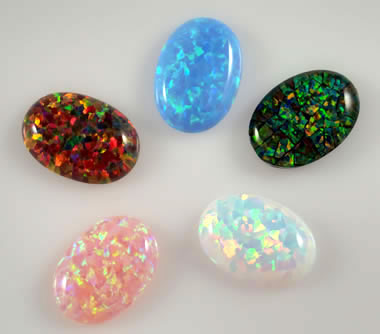
A Few Dollars Each: Attractive synthetic opal cabochons like the ones shown in the photo above can be purchased at retail for a few dollars each. That price would be much lower if they were being purchased in large quantities. Manufacturers in countries where labor costs are low have become so efficient that the cost of a cabochon is minimal. Image copyright iStockphoto / jillyafah.
Synthetic Opal's Price Advantage
The main reason that people produce synthetic opal is a hope of being able to manufacture it at scale and at a price that is lower than natural opal. They have been incredibly successful. Many types of synthetic opal are now cut into beautiful ring-size cabochons that sell for just a few dollars each. Even the very best synthetic opal can be cut into cabochons and sold for just a small fraction of the price of natural opal cabochons of similar size and appearance.
Synthetic opal certainly wins some buyers away from natural opal, but it is not likely to displace natural opal from the gem and jewelry market. Why? Most people who love opal are glad to pay a higher price to own a gemstone that formed within the Earth - and, in their opinion, no synthetic material will ever compete with that! These people insist on the real thing!
The Many Uses of Synthetic Opal
Synthetic opal is a beautiful material, and its wonderful play-of-color is appreciated by many people. It is therefore no surprise that its use as a decorative material has extended far beyond jewelry. Shapes, small particles, and thin sheets of synthetic opal are being used to adorn musical instruments, jewelry boxes, vases, art objects and many other items.
Kyocera, a leading manufacturer of synthetic opal, has developed a fast-drying gel that contains tiny suspended particles of synthetic opal that can be used as a fingernail polish. [2] The future will certainly see synthetic opal being used in a wide variety of applications.
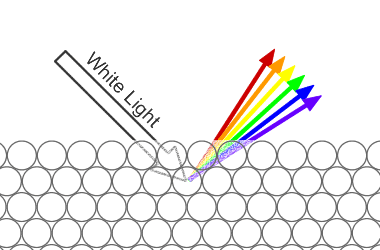
Play-of-Color in Opal: The spectacular play-of-color exhibited in natural opal is caused by light interacting with millions of sub-micron silica spheres neatly stacked within the opal. As light passes through these neatly-stacked spheres, it is diffracted into its component colors, and exits the stone in a flash of spectral colors. These tiny spheres were discovered in 1964, revealing the recipe for making synthetic opal.
How Synthetic Opals Are Made
The cause of opal’s play-of-color was discovered in 1964 using an electron microscope. An array of tiny silica spheres, with a uniform size of less than ½ micron in diameter, in a close packing arrangement, serves as a natural diffraction grating to separate visible light into the colors of the spectrum. [3] [4] This discovery revealed how opal’s fabulous play-of-color is produced and provided the blueprint for making a synthetic precious opal.
The first synthetic opals were made by precipitating tiny silica spheres of uniform size, and allowing them to settle into a close packing arrangement. The spaces between the spheres were then filled with a binding medium that would harden, hold the structure together, and allow the diffraction of light. [5]
Creating synthetic opal was different from the creation process for most other synthetic gem materials. Other gem materials are single crystals, and growing the crystals is the key to producing the gem material. Synthetic opal creation presented multiple challenges: creating millions of spheres of identical size; settling them into perfect arrays (which requires as much as a year or more of time); and, binding the spheres together into a material with a durability that is suitable for a gem. Binding the spheres often requires impregnation of the opal by a polymer resin, an ingredient that is not in natural opal. In addition to improving durability, the polymer resin can improve translucence, luster, and color. Synthetic gem materials are often treated for the same reasons as natural gem materials.
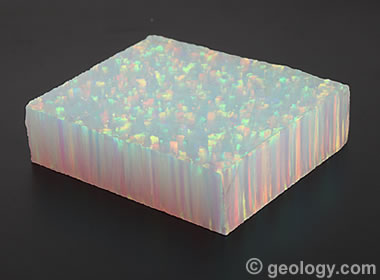
Columnar Growth Pattern: The photo above shows a block of rough synthetic opal revealing its columnar growth pattern. The columns are the vertical features visible on the sides of the block. This block is approximately 1 1/2 inch x 1 1/2 inch in size.
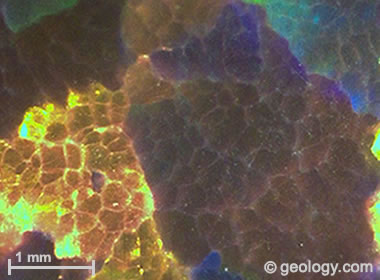
Chicken Wire or Lizard Skin: Many types of synthetic opal display a chicken wire or lizard skin pattern when a polished surface is viewed under magnification in reflected light. Each "cell" or "scale" in this pattern represents the outline of a growth column of the synthetic opal.
Identifying Synthetic Opal
Synthetic opal has been in the marketplace since the 1970s. Many of the early synthetic opals could easily be separated from natural opal with a quick examination unaided by magnification; however, the manufacturers of synthetic opals have been improving the appearance of their products, and today many of them are more difficult to detect. Features that a synthetic opal might exhibit to reveal a laboratory-grown origin include:
 1) the play-of-color patches might display a columnar growth pattern when viewed perpendicular to the growth direction (see accompanying photo); 1) the play-of-color patches might display a columnar growth pattern when viewed perpendicular to the growth direction (see accompanying photo); 2) under magnification, a synthetic opal's play-of-color areas might exhibit a "chicken wire" or "snake skin" pattern (see accompanying photo); 2) under magnification, a synthetic opal's play-of-color areas might exhibit a "chicken wire" or "snake skin" pattern (see accompanying photo); 3) resin-impregnated synthetic opal often has a lower specific gravity than natural opal; 3) resin-impregnated synthetic opal often has a lower specific gravity than natural opal; 4) play-of-color patches are often more uniform in size and distribution across the face of a synthetic opal; 4) play-of-color patches are often more uniform in size and distribution across the face of a synthetic opal; 5) synthetic opals are sometimes stained an outrageous color, or the stain produces absorption bands when viewed through a spectroscope. 5) synthetic opals are sometimes stained an outrageous color, or the stain produces absorption bands when viewed through a spectroscope. |
Expert Identification Assistance
Using the features above, much synthetic opal can be confidently separated from natural opal, but some synthetic opals can be challenging to identify - even by trained gemologists, including the author of this article. Fortunately, if a gemologist is uncertain about the identity of an opal, it can be sent to a laboratory where experts with analytical instruments can identify it for a fee. The cost of this service is usually under $100 per specimen.
You can see a sample laboratory report for a synthetic opal cabochon, prepared by the Gemological Institute of America, here.
| Synthetic Opal Information |
|
[1] Gemological Report 6204505178 issued by the Gemological Institute of America Laboratory, August 13, 2019.
[2] Synthetic Colored Opals: Examples of Finished Products: a page on the English version of the Kyocera website, accessed September 2019. [3] Structure of Opal: by J.B. Jones, J.V. Sanders, and E.R. Segnit. Nature: Volume 204, pages 990 to 991; 1964. [4] Colour of Precious Opal: by J.V. Sanders. Nature: Volume 204, pages 1151 to 1153; 1964. [5] Gems Made by Man: by Kurt Nassau. The Gemological Institute of America, 364 pages, 1980. |
| More Gemstones |
 |
Tourmaline |
 |
Fancy Sapphires |
 |
Diamond |
 |
Canadian Diamond Mines |
 |
Birthstones |
 |
Pictures of Opal |
 |
Fire Agate |
 |
Blue Gemstones |

Find Other Topics on Geology.com:

|

| ||

|

| ||

|

| ||

|

|
